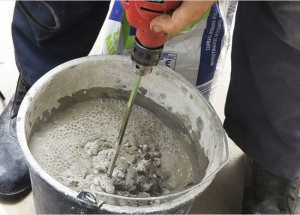You can manufacture the paving slab yourself. To do this, you need to know what materials are needed for high-quality composition, what tools are used for casting and what kinds of plates and types there are. We'll talk about all this in the article below.
Content
Forms for making tiles, what is it?
Form for tiles is a kind of frame, in which concrete is poured. Then the mixture takes the form of this very skeleton, is kept in the placed form until it dries completely and is removed for its intended use. Forms for making tiles can be made by yourself or purchased at the store. In building supermarkets you will find all the necessary materials for manual production: wooden slats, plaster, nails, shapes, containers, stencils.
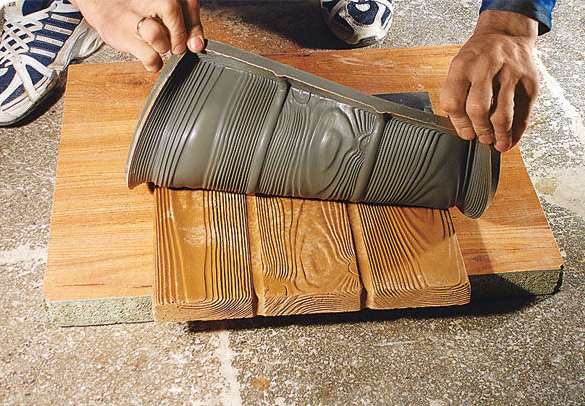
There are a lot of differences among ready-made forms. First of all, the differences are in the quality of the material, then in size, in forms. It is customary to distinguish the following forms for the manufacture of paving slabs:
- Shape of wood - wooden frame, which is designed for repeated receipt of tiles. However, due to the lack of moisture-resistant coating for a long time this form is not enough. However, this option is recognized as the most economical and can be produced independently;

- Form of silicone - has a strong coating, this form can be used for a long time. After the production of the tiles, the finished semi-finished product is well separated from the silicone walls. Such forms can be used not only for the manufacture of paving slabs, but also for the production of facade or decorative tiles;
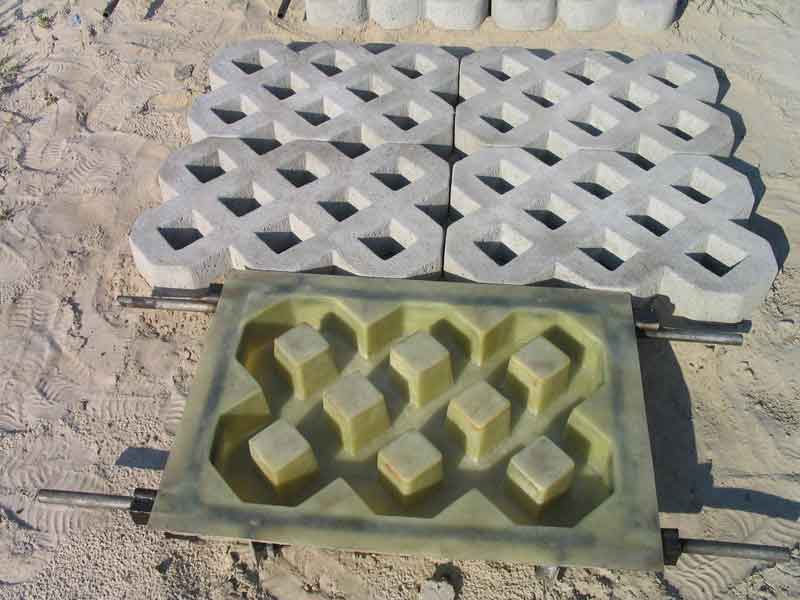
- Plastic mold - inexpensive and also a reusable tool. Sold in supermarkets in various shapes and sizes. The most durable forms are made of polyesterol. One of the obvious shortcomings of such forms is the difficult notch. This problem can be solved with the help of lubricants;
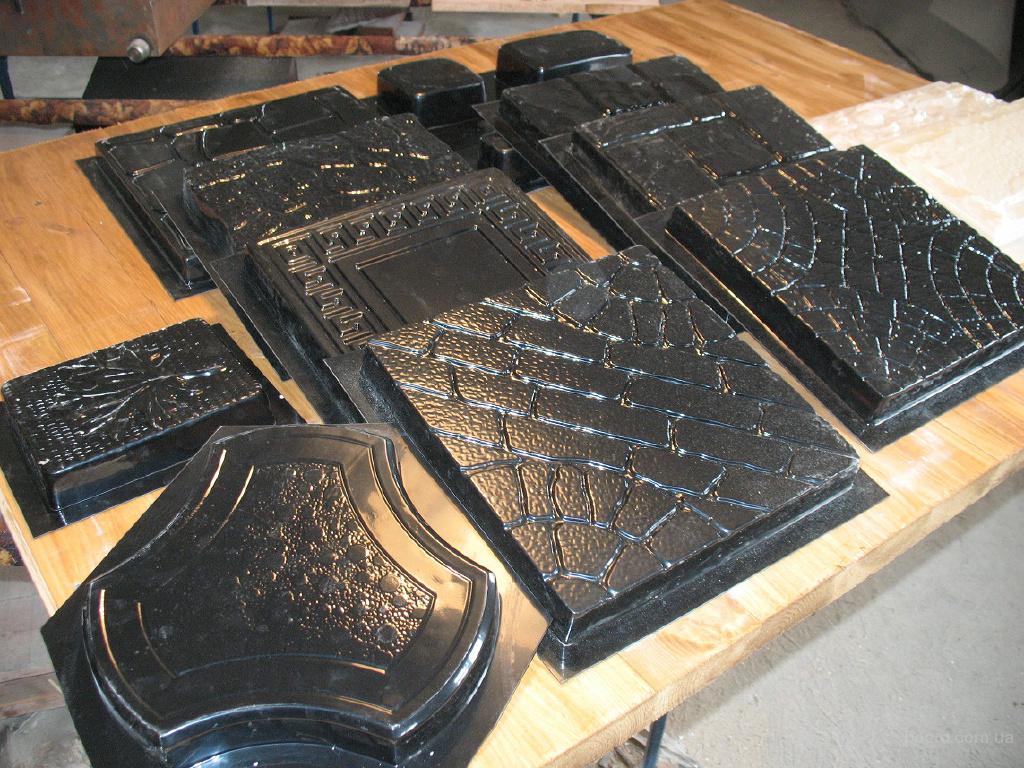
- Metallic form - one of the most enduring options. Upon completion of the production of the tile in this form, it is easily extracted by tapping. In this case, the design of the form remains intact. When choosing metal molds, it is necessary to stop on stainless steel molds, because when in contact with water, pure iron structures are easily oxidized;
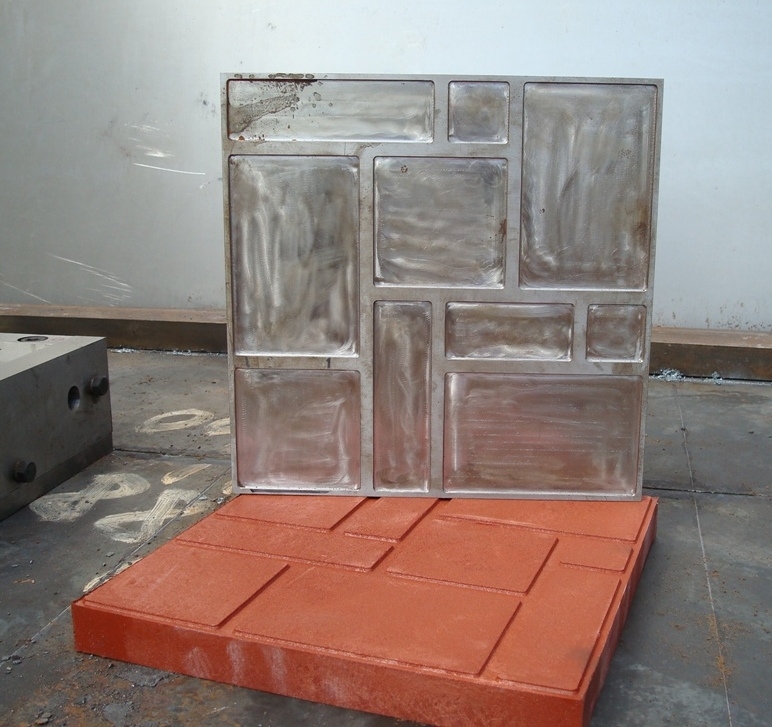
- Forms from improvised materials - Forms in the form of containers will be suitable for masonry. It is worth choosing a container with smooth edges without rounded corners. So the finished tile will be easier to dock without gaps.
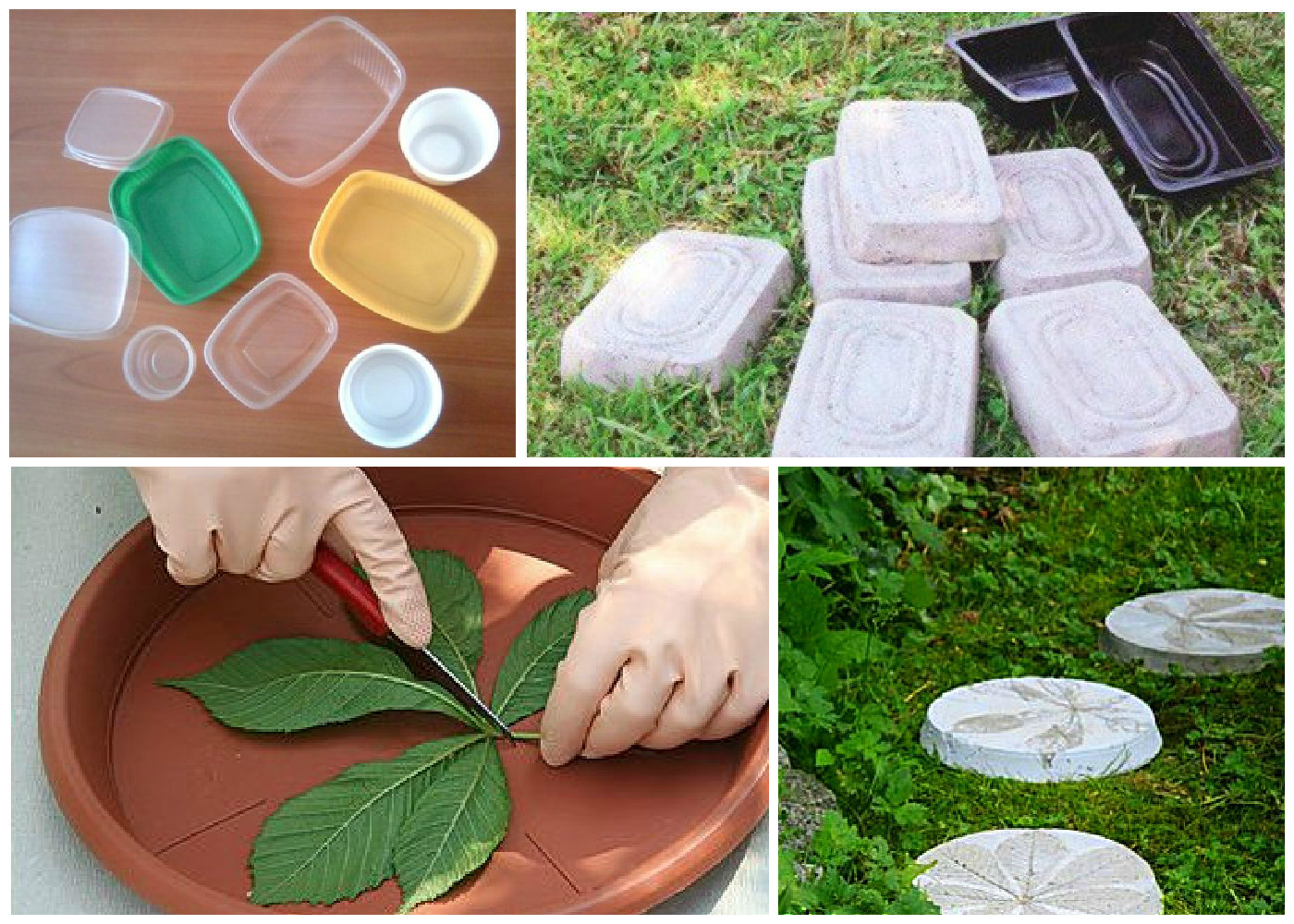
Plastic molds for making tiles
Forms of plastic - the most affordable tool for making tiles. He endures more than 100 products. From the polymer material, you can choose the most suitable texture. Inexpensive forms can be triangular, round, rhomboid, cellular, standard square or rectangular. They can be bought in any building supermarket or made of liquid plastic.
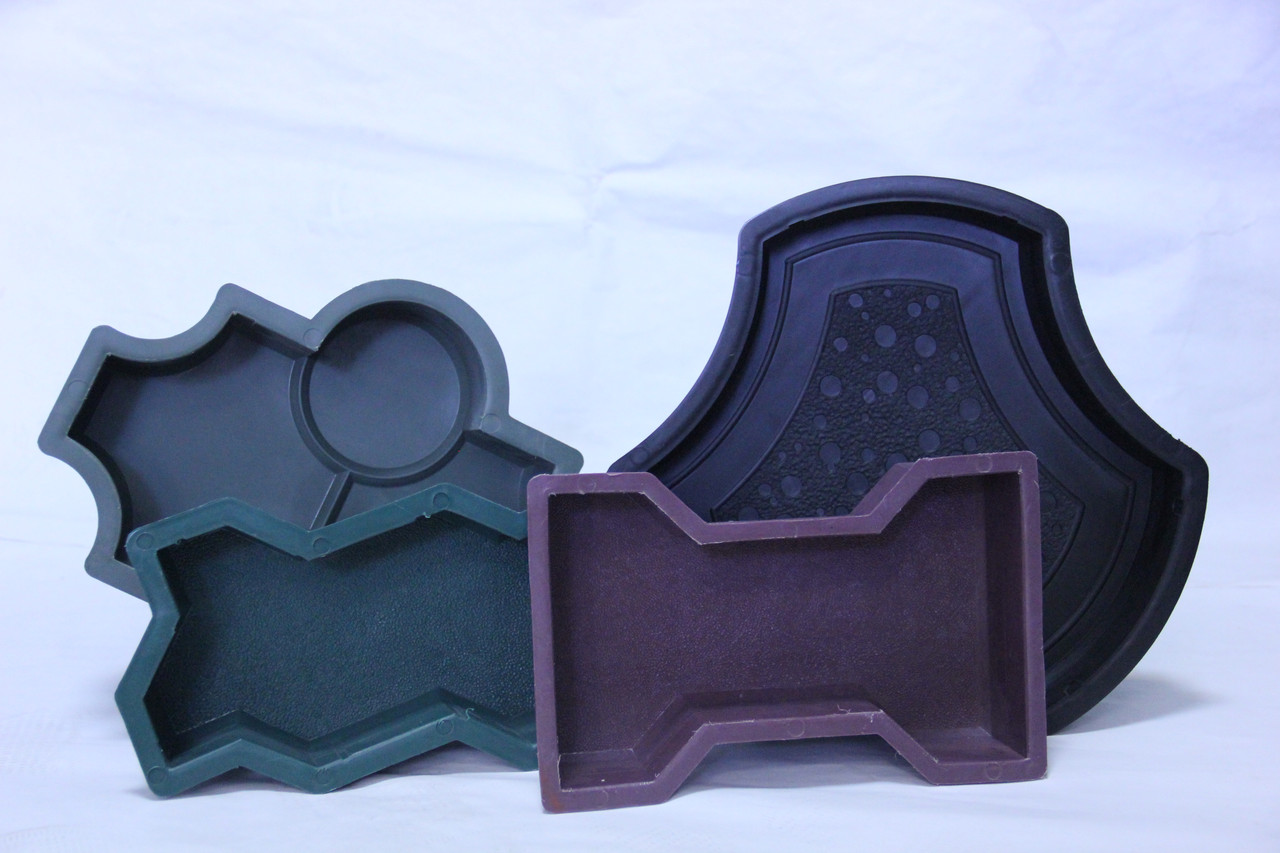
Polyesterol is used for the production of tile forms. This is the most durable polymer from the discharge of plastic substances. As a rule, it is sold in the form of granules. When working, they heat up and pour into the wooden frame, which is inserted into the mobile tray. After the mold has cooled, the skeleton is dismantled, and the inner surface is rubbed with a sandpaper. So, the edges of the shape will be as flat as possible. Subsequently, the cell is lubricated with oil and can be used for work.
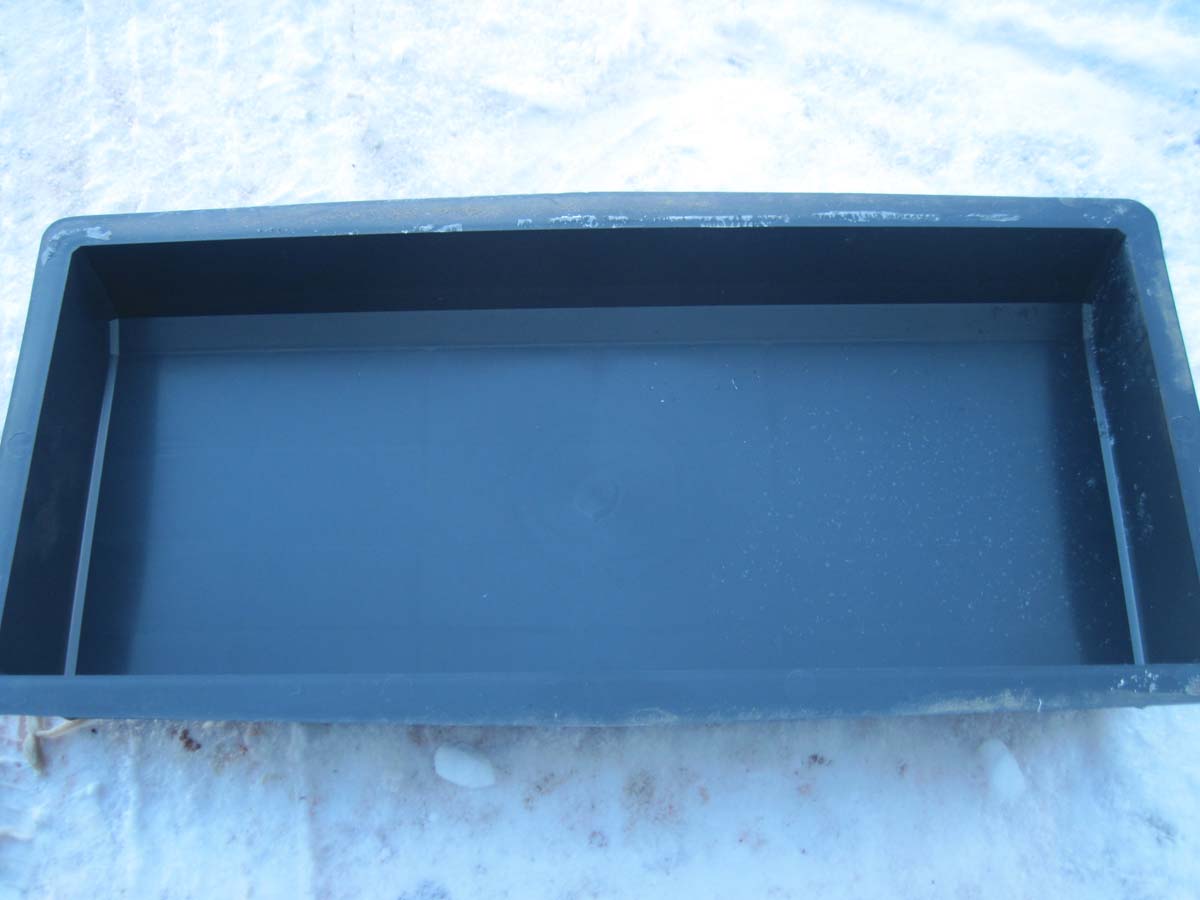
Production of paving slabs with your own hands, step by step
The simplest and most reliable form for the manufacture of paving slabs, which even a beginner can get, is a wooden form. It can be made from boards or planks. Only the design of such a tile will not be the most intricate. As a rule, these are wooden and square shapes of the same size. Similarly, in this likeness, you can make a frame in the form of a house, a rhombus, a rectangle. The difficulty of design lies in the multiple bonding of the walls of the mold. If you are ready for experiments, then stock up on nails.
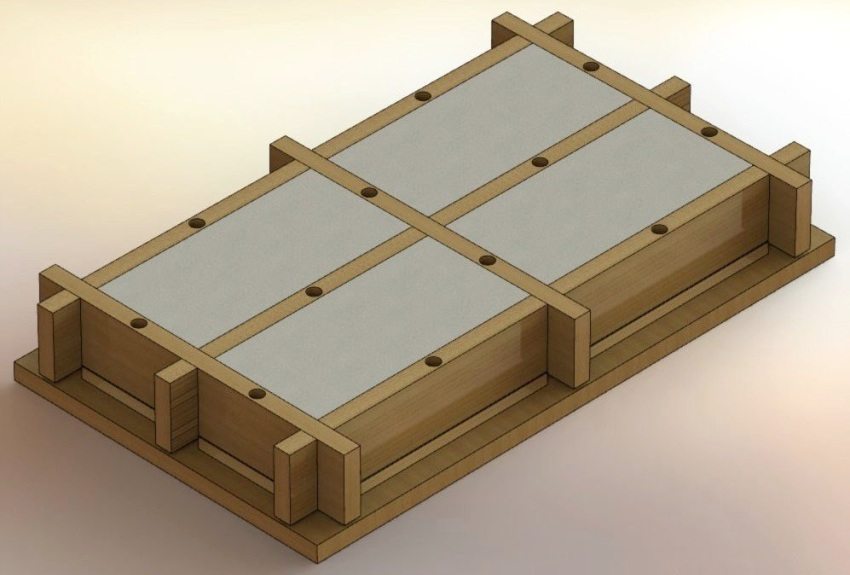
tools, devices, supplies
Before you start to make a mold, you need to make the very form from which we will get the paving slab. You can make it according to a previously drawn sketch. So it will be clear how much material will be required for harvesting. All you need is a simple pencil, ruler and blank paper. Variants of materials for the form can be very different from wood to metal. We will consider the simplest example - the form of a tree.
Make a wooden form for making tiles can be as follows:
- Take a piece of paper, sketch with an approximate shape and size. This can be a square, a rectangle, a rhombus or other shapes. Consider the manufacturing options, so that they are convenient to make from the selected material;
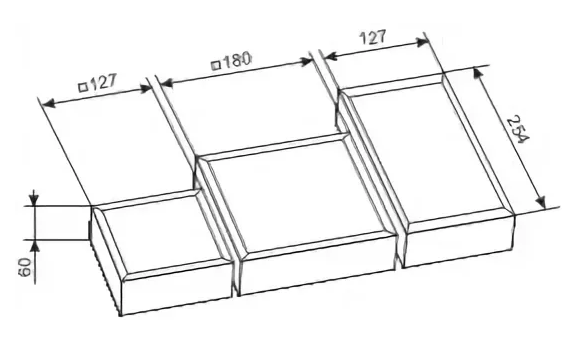
- Transfer these parameters to the materials. Measure on the tree the length, width and height of the slats;
- Using a hacksaw or jigsaw, cut the bars into the right parts;
- Fix the brackets together with staples or nails.
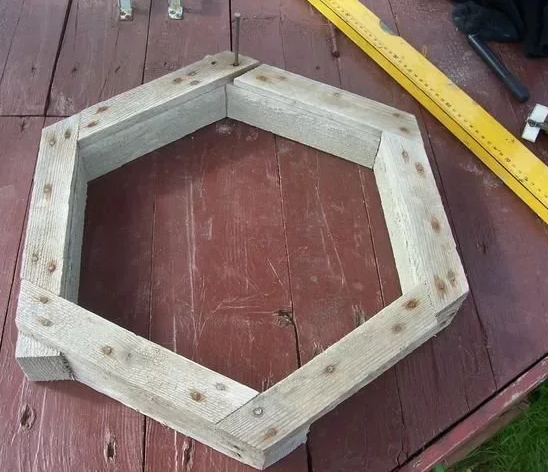
equipment for the manufacture of paving slabs
Many craftsmen are mistaken in that for the manufacture of paving slabs only a form is needed. In addition to the form, you need to prepare many more auxiliary tools:
- The form - the main tool that you can buy in the store or make your own;
- Tray or stand- it is here that you need to put the filled form with the cement mixture. There it will dry, and stay until the moment of extraction. If you are planning a mass production of tiles, it is better to get a large shelf or a pallet;
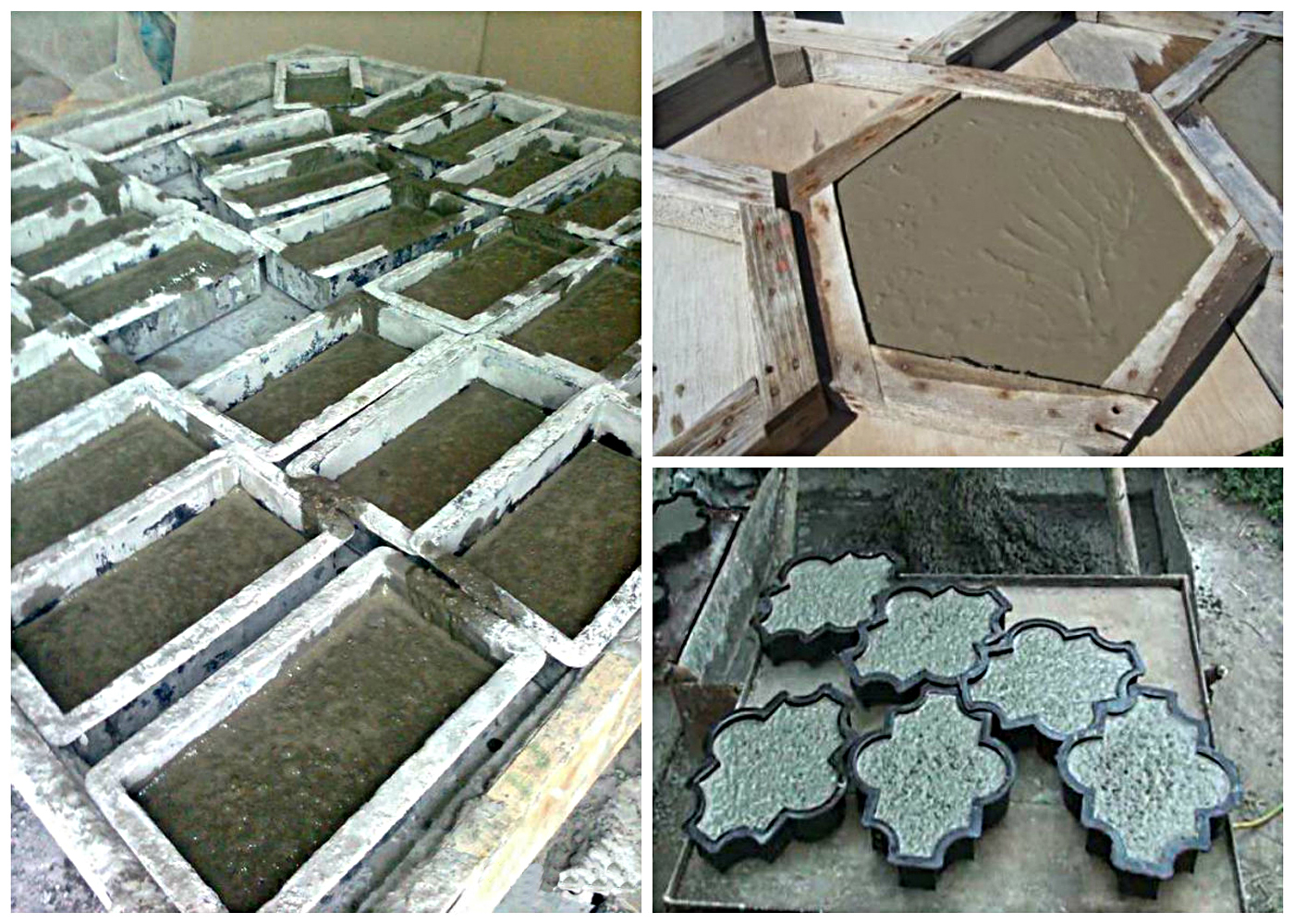
- Capacity - it is needed to mix the solution. It can be a metal vessel or a plastic container, designed specifically for mixing mortars. Instead of capacity, you can use concrete mixer;
- Shovel - for cement mixing;
- Scoop - for unfolding the mixture on tiled forms;
- Lubricant - for smearing the molds in order to avoid blocking the mixture with the walls of the frame. For this purpose, you can use ordinary vegetable oil or fat, also in building stores special anti-adhesive lubricants for molds are sold;
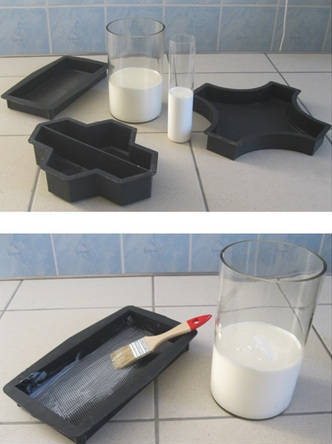
- Level - with the help of it you will determine whether the shape or series of forms is exactly equal;
- Reinforced mesh - increases the strength of the structure;
- Putty knife - necessary for leveling the surface;
- Vibrating table - required for the manufacture of tiles by the method of vibration;
- Sandpaper - with abrasive layer H6-8. Needed to complete the grinding on the surface of the paving slab.
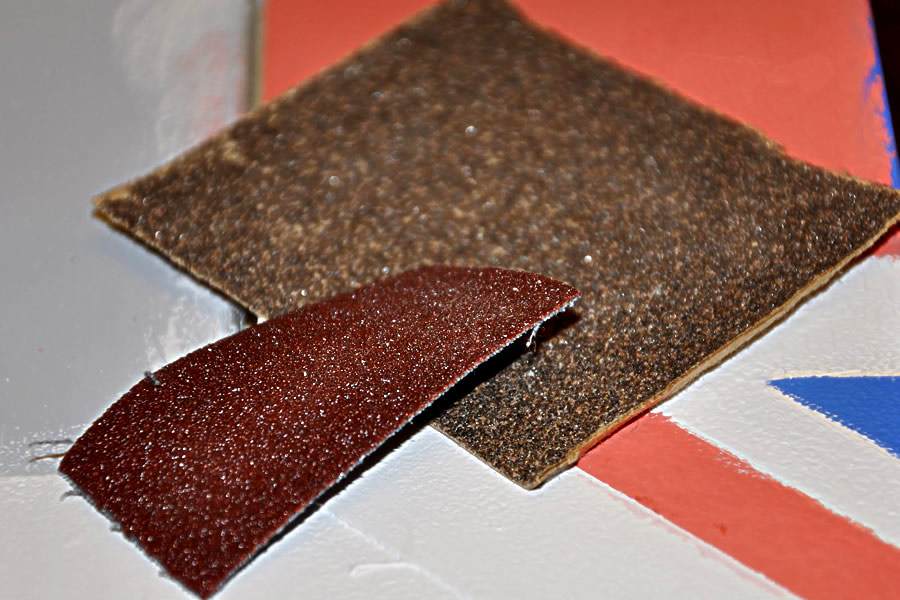
cement for paving slabs, how to choose
Cement for the production of tiles should be selected in accordance with the quality characteristics that can be used for making tiles. Such cement should not fall apart, it should contain a certain proportion of cement clinker, gypsum and some of the mineral additives. The standards for the content of substances are determined by GOST. Information on the quality of the composition is always prescribed on the packaging and the accompanying documentation.
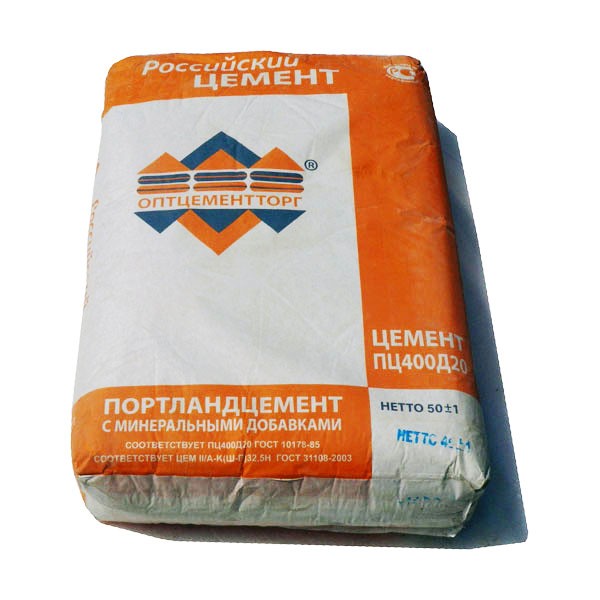
Ideal for the manufacture of paving slabs will be cement grade M-400, PC-400 or PC-500. All that contains the figures below, for the production of tiles is not suitable. The first option, M-400 is suitable for masonry. PC-500 and related solutions are suitable for more professional manufacturing. Such masses can withstand heavy loads and are characterized by increased strength.

Abbreviation PC means portland cement. Values 400 and above indicate the degree of hardness of the material. D - indicates the presence of additives, if the numbers next to this letter are equal to - 0, then, the cement mixture does not contain additives. GOST admits impurities from mineral substances, as well as phosphorus, fluorine, boron in the amount that permits the relevant documentation. Quality cement does not have any extraneous smells, it simply does not have GOST raw materials. The color of Portland cement is from gray to gray-green in color, where shades of green indicate the admixture of iron. It is better to purchase material in construction stores, where you will be guided by the appropriate brand, series and name.
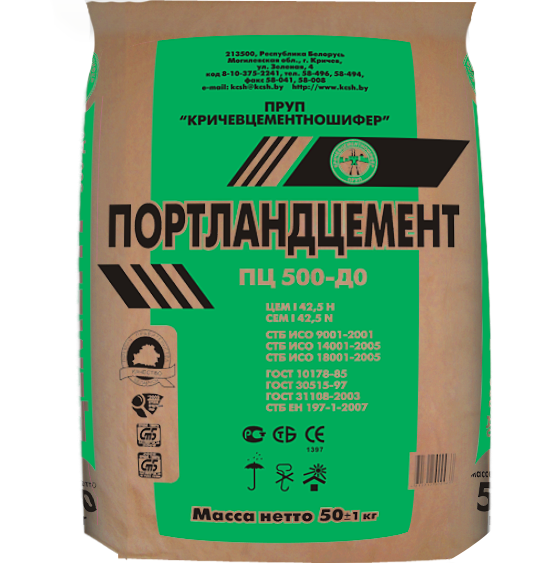
we prepare a sand-cement mix
Sand-cement mixture is the material from which paving slabs are made. You can prepare it without any special devices. It is enough to stock up with quality cement (not lower than M-400), sand, gravel, plasticizer, modifier and dye if you want to produce a colored tile. As a kneading equipment, you can use a concrete mixer or a conventional trough with a shovel. Prepare a solution for molds in a ratio of 1: 2: 2, first a part of the water, then two parts of cement, then add 2 pieces of crushed stone.
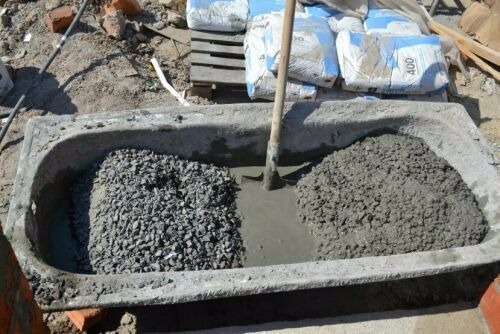
As a rule, in shops, cement is sold with the packaging of 25, 50 kg. At 50 kg of cement we need 2 buckets of water (about 20 liters). The water is taken in fresh pure form, added to the tank for vymeshivaniya. A plasticizer is prepared from above. It is prepared according to the proportions for a certain amount of kg. In our case, 50 kg. Then the dye is filled up, if it is prescribed by your recipe.
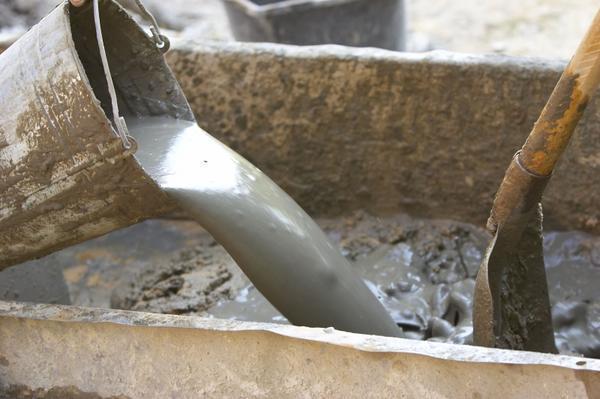
After the crushed stone is added. The fine fraction is filled up in the amount of 3 buckets of 12 liters. The mixture is thoroughly mixed, then in the same amount (3 buckets or 50 kg) cement is added. The mixture is again thoroughly mixed. In the homogeneous mass obtained, the bucket of rubble is again filled, mixed, then sand is added. Next, you need 4 buckets of sand. After each bucket the solution is mixed. If the mass is not enough liquid, you can pour in a little water. The last stage adds one more bucket of crushed stone (12 liters). Now the resulting mass is mixed to a uniform density and spreads over the molds. It will be better if the finished forms are covered with a film. So, no debris or sudden precipitation will not spoil the tile. To form not adhere to the solution, they must be pre-lubricated with oil or a special anti-adhesion mixture.
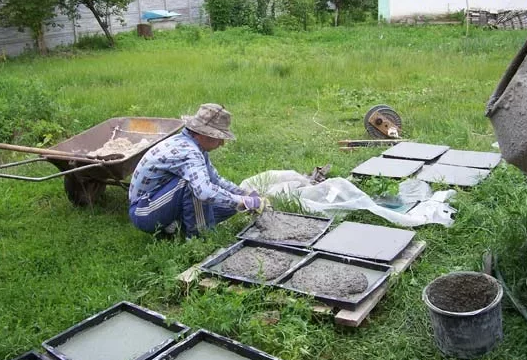
Technology of manufacturing paving slabs
In fact, there are three types of technology for the manufacture of paving slabs:
- Vibropress;
- Vibration;
- "With your own hands."
One of the most complex and costly processes is the manufacture of tiles under vibropress. Molds with tiles are kept on a vibrating table / vibrating shelf, then pressed with a machine and only then they wait for drying. This production is the most reliable. The mortar mass becomes as fast as possible during the treatment. All the particles of the mixture are joined together as closely as possible. Ready tiles made with vibropress can be laid out on paths with high-intensity movement.
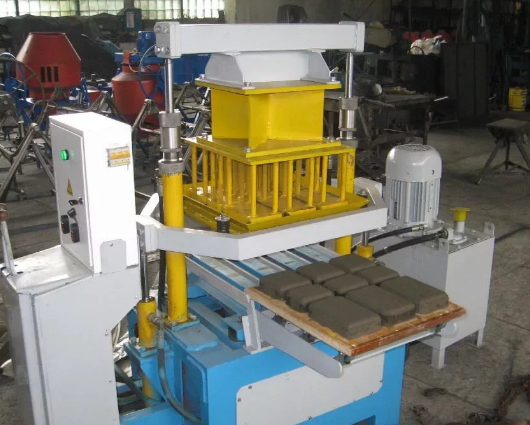
Tiles for pavements, manufactured by the method of vibration, can also be used for pedestrian paths, parks, piling at stops, in yards. It is prepared on a special table with running vibration from 2 hours. After this, the vibration mode is turned off and the molds dry naturally within 2 days.
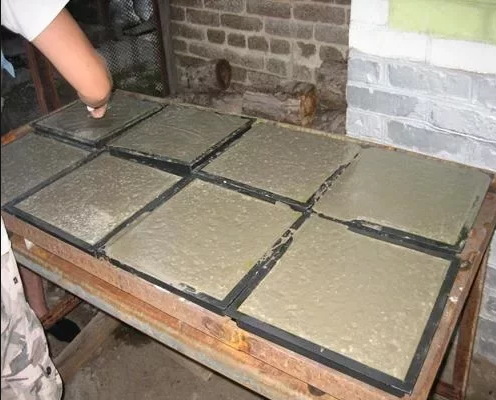
The independent manufacture of paving slabs most often does not provide either a vibrating table or a vibropress, since it is an expensive equipment. The manufacturing process is limited to kneading the solution in the container and the layout of the molds. Such a tile is considered more fragile and is suitable only for home use: laying of garden sidewalks, space near the house, gazebo, barbecue. That is, in those places where there is a small amount of traffic.
Helpful Tips
- All forms for the manufacture of paving slabs are designed for a certain number of casts. In addition, the tile dries within 2 days. Therefore, make as many forms as possible. So you can make the necessary amount of tiles in a short time;
- The easiest extraction of plates comes from plastic and silicone molds. This is explained by their flexibility and plasticity;
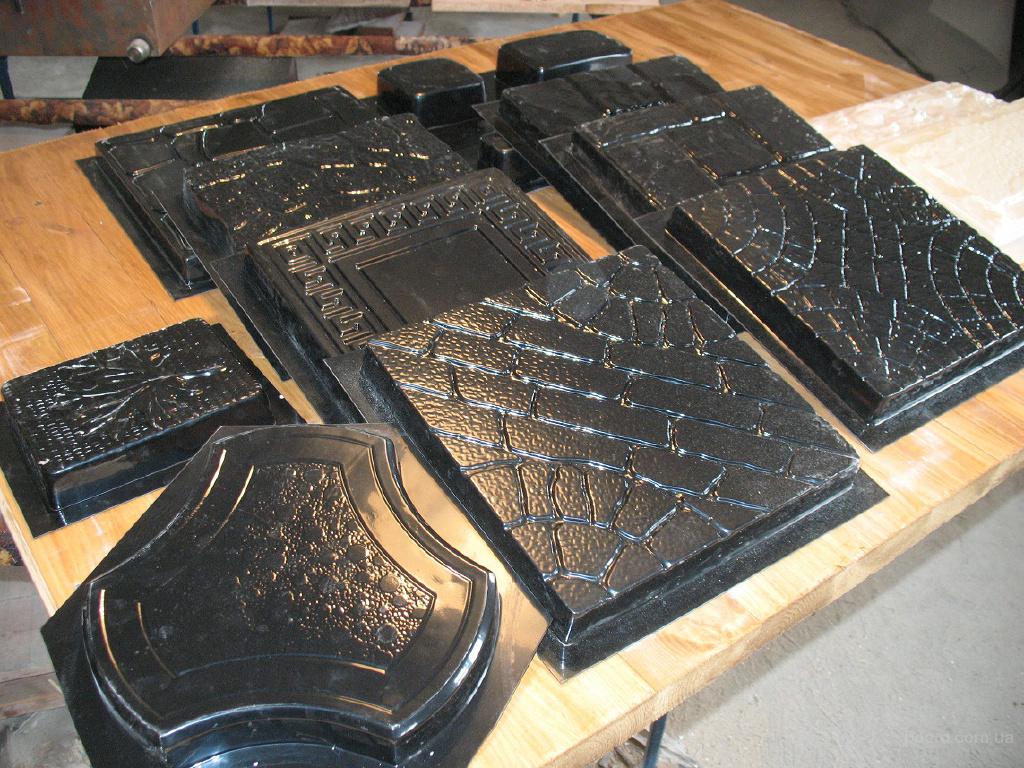
- Mix only the amount of solution that will fit in the existing molds. Otherwise, the solution will dry up and disappear. Even if you try to use for a tile a mixture of two or three days ago, then know that such a tile will cover with small cracks and disintegrate;
- If you have a cement mixture left, use it to cover the cracks in the walls of the house;
- When manually kneading a tile mixture, instead of a shovel, you can use a drill with a nozzle for mixing solutions;
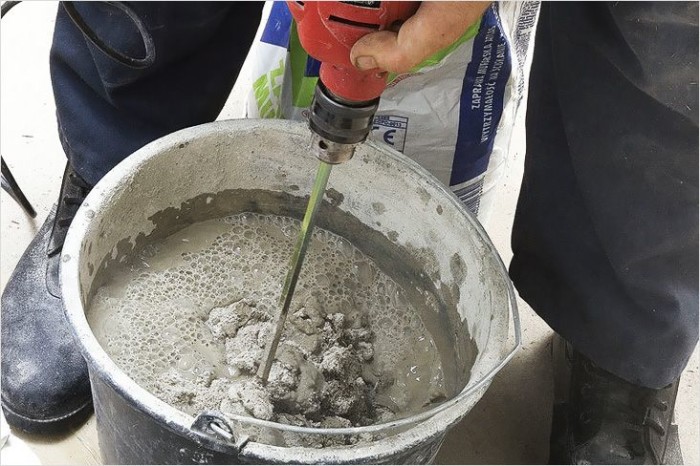
- As forms for the production of tiles, you can use not only food containers, but also trimming large diameter pipes;
- Use only high-quality materials for the preparation of sand-cement mixture. All of them should be free of foreign impurities and debris;
- Never use the tile until completely dry. The drying process takes much more than 2 days. After 2 days you can simply safely remove the material from the mold, but the tile cavity is evenly dried only after 10-12 days.


